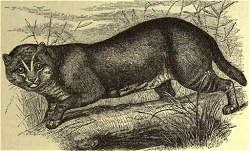Flat-headed cats

One of the problems for those studying wild cats is that cats are elusive creatures. Domestic cats can make themselves hard to find, but when the species in question is a very shy creature which lives in a difficult and inaccessible habitat, biologists face a real challenge to find out much about them. Such is the case with the asiatic Flat-headed cat - perhaps the rarest and least-known of the world's small wild cats.
As you might expect, the Flat-headed cat gets its name after the very distinctive flattened shape of its skull. Though mainly found in the wetlands of the Thai-Malay Peninsula these exotic cats also can be found in the wilder and wetter parts of Borneo and Sumatra. Indeed the very first Flat-headed cat to be described was seen in Sumatra.
Economic development in Indonesia and other parts has led to the wetlands which make up the Flat-headed cat's habitat being steadily turned into plantations for cash crops. With the decline of the wetlands, it is assumed that the number of flat-headed cats is also diminishing. However, because these cats are small, shy and elusive, it is very hard to estimate the rate of decline, or indeed to estimate how many there were in the first place. However, according to the International Union of Conservation of Nature (IUCN), fewer than 2500 flat-headed cats may remain. (http://www.iucnredlist.org/apps/redlist/details/18148/0)
The Flat-headed cat is among the smallest of wild cats, weighing between 1.5 to 2.5 kg (3.3-5.5 lb). Its body is slender, with the head and body of larger specimens growing to 50 cm (20 inches) in length. The back end has a remarkably short tail of about half the length of the body. The shape of the head is dominated by a depressed skull which is definitely the cat's most distinctive feature. This flattish skull extends to a somewhat triangular muzzle with two striking lines of white fur running between the eyes to either side of the nose. Ears are small and set well down on the side of the head. The eyes are large and close-set.
The little cat has attractive, thick fur. This is reddish on the top of the head and dark-brown on the top of the body. The belly is white as are the facial markings. As might be expected of a cat which has adapted to wetlands the feet are somewhat webbed. In fact this cat has even more webbing on its feet than has its close cousin - the fishing cat. Like the fishing cat, flat-headed cats probably have a highly piscine diet supplements by frogs and other amphibians. The catís highly developed canine teeth are excellent for capturing wriggling, slippery prey.
So little is known about the flat-headed cats that even the assumption that their diet is mainly fish is based on a study of the stomach contents of a single cat which was shot on a Malaysian riverbank. There are very few Flat-headed cats captivity (less than ten in Thai and Malaysian zoos). These seem to prefer hunting for prey in the water rather than on dry land, although like any other cats, they happily catch rodents and small chickens if these are available (another risk to the species in the wild is that the cats are caught in traps set up to protect chickens).
Female Flat-headed cats, observed in captivity are crepuscular. This means, like most domestic cats, they are active in the morning (from about 8 am to 11 am) and in the evening between 6 and 10pm. Most of the rest of the time is spent napping.
Taxonomy
Originally, the flat-headed cat was placed in the genus Felis by Vigors and Horsfield who were the first to describe the cat in 1827. But in 1961 a German biologist - Weigel - reclassified this cat into the genus Prionailurus. This taxonomic placement was confirmed in 1997 by researchers from the National Cancer Institute who performed detailed genetic studies. The genus Prionailurus contains four species of small, spotted wild cats found in Asia: The Leopard Cat (Prionailurus bengalensis); Rusty-spotted Cat (Prionailurus rubiginosus); the Fishing Cat (Prionailurus viverrinus) and the Flat-headed cat (Prionailurus planiceps). So far no subspecies of the Flat-headed cat has been reported.

